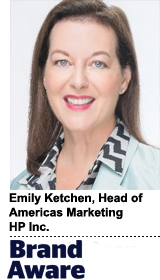
“Brand Aware” explores the data-driven digital ad ecosystem from the marketer’s point of view.
Today’s column is written by Emily Ketchen, head of Americas marketing at HP.
Despite criticism that it is just a marketing gimmick, brand transparency is more relevant and meaningful than ever. It is becoming fundamental to how companies engage with customers.
By transparency, I am not referring to the growing requirement for ad tech vendors to shine a light on all aspects of their operations or the disclosure of every ingredient in a product. While those processes are important, in this case, I’m discussing being upfront about how a brand is getting to know its audiences in order to develop relationships with them and, subsequently, sell them products or services.
It is about owning your intent and building trustworthy connections with audiences.
Doing so will not come naturally for many marketers. We want to be truthful, but history and training tell us that engaging customers is often about the subtle sell or providing a product that will make them want to spend time with the brand. Maybe you offer a free vacation with the intention of selling them a timeshare. Or perhaps you tell them they’ve won a prize at your car lot during an annual blowout sale.
Such tried-and-true methods still work. However, in an age where we are all online, generating tons of data and receiving a barrage of ads every day, they are no longer as relevant or compelling as they once were. When collecting customers’ data to personalize interactions, brands owe it to customers to communicate how they are doing so and why. Not only will this reduce the potential “creepiness” factor, it will also make customers feel like history with the brand and preferences are remembered and honored.
Today’s consumers overwhelmingly prefer brands that play it straight, which is why transparency has become a leading currency in modern marketing.
Taking transparency to heart
While some brands have certainly fumbled when it comes to transparency, many have done an exceptional job of engaging with audiences in authentic ways. The outdoor clothing brand Patagonia, for example, staked its entire reputation on a three-pronged mission statement: to build the best product, cause no unnecessary harm and use business to inspire and implement solutions to the environmental crisis. These aren’t just words.
Patagonia lives and breathes its values with its marketing strategy, even when it might be controversial. Recently Patagonia estimated it would save $10 million from a polarizing 2017 tax cut. Rather than reinvesting it in the business, Patagonia donated the money to environmental protection groups.
At HP, we strive be clear about our intentions when engaging customers. For example, at festivals like Coachella Valley Music & Arts Festival, we don’t hide that we’re trying to get attendees to spend time with our products. We are clear from the start: We want to show how our technology is enabling shared experiences, such as with the HP Coachella Wall, an interactive digital wall where attendees manipulated a visual landscape with bodily motions.
The power of consistency in transparency 2.0
We’ve brought this type of experiential marketing to life at different festivals, and a key lesson we’ve taken away from each activation is the power of consistency. Repeat attendees of these events have often seen our activations and continue to line up, even three years later. But consistency sometimes falters. And transparency means being willing to own up to your mistakes.
Brands cannot afford to brush off transparency as a buzzword. Viewing it, instead, as a constantly evolving and valuable marketing practice – Transparency 2.0, if you will – creates an opportunity to elevate a brand in the eyes of consumers. Successful brands have shown that authentic transparency is far from just a talking point. When practiced consistently, it becomes an entry point to building lasting relationships with valuable customers.
Follow HP (@HP) and AdExchanger (@adexchanger) on Twitter.
This post was syndicated from Ad Exchanger.


More Stories
Everyone must go Tourism NZ campaign is no 100% Pure… But this might just work
Waka Kotahi tackles drug driving with FCB and MBM
Unbound joins HubSpot for elite client data